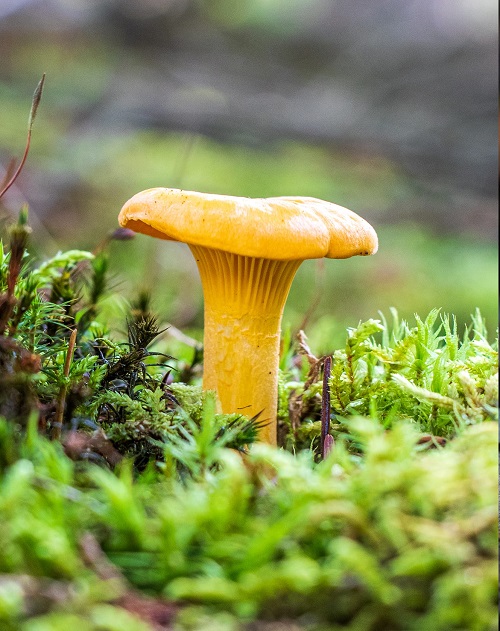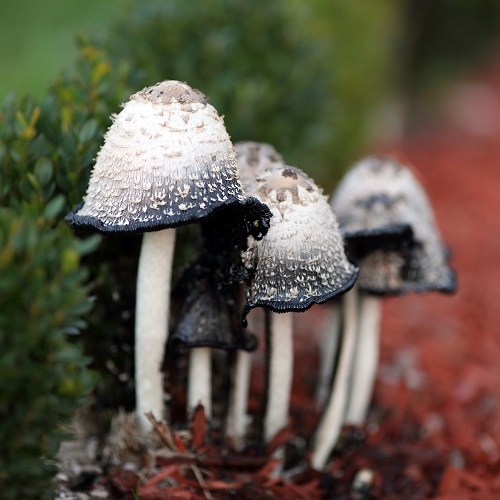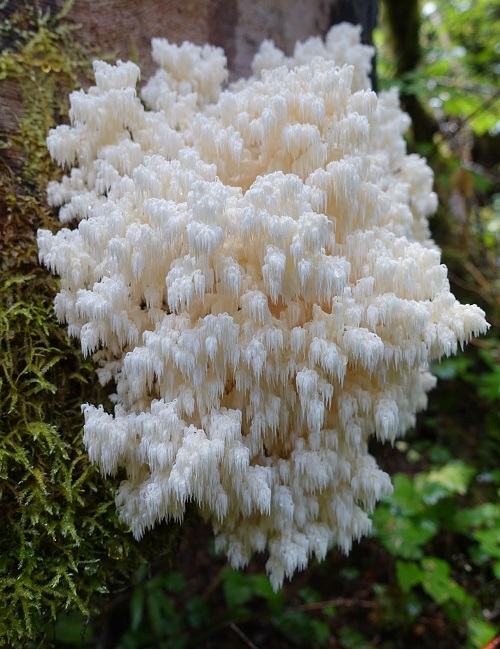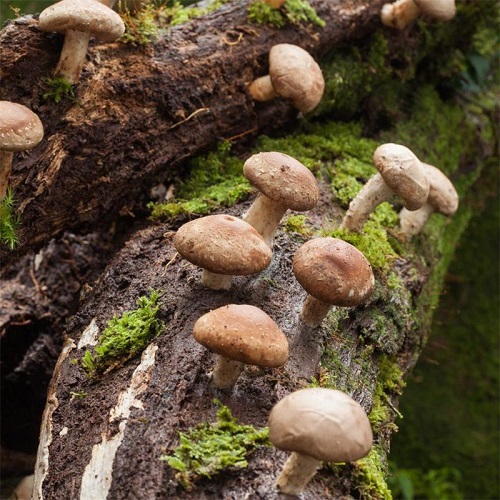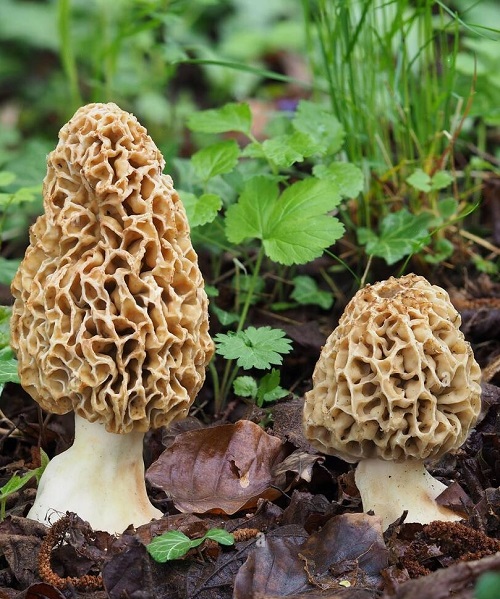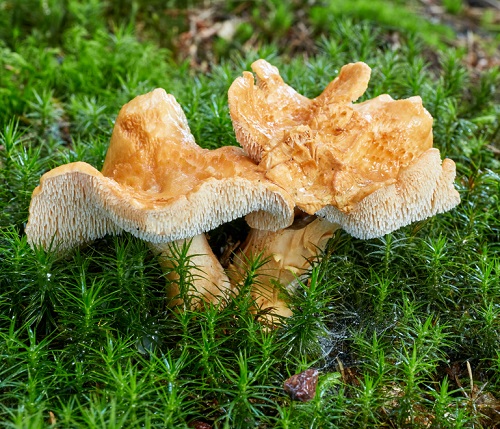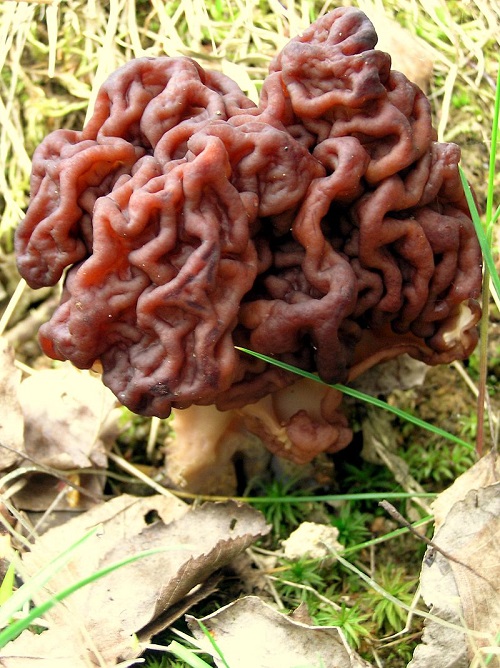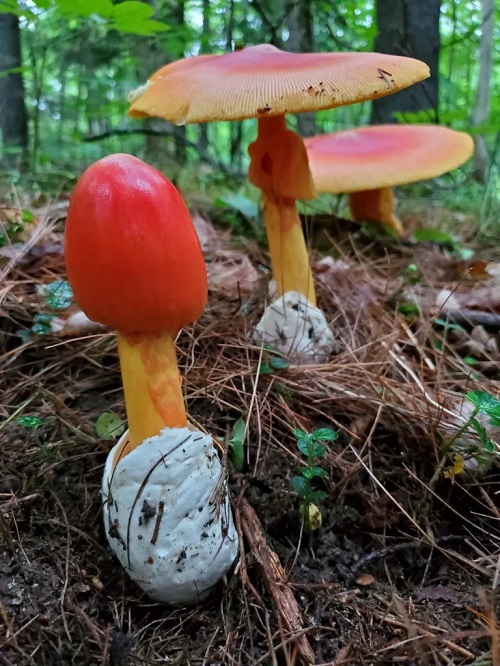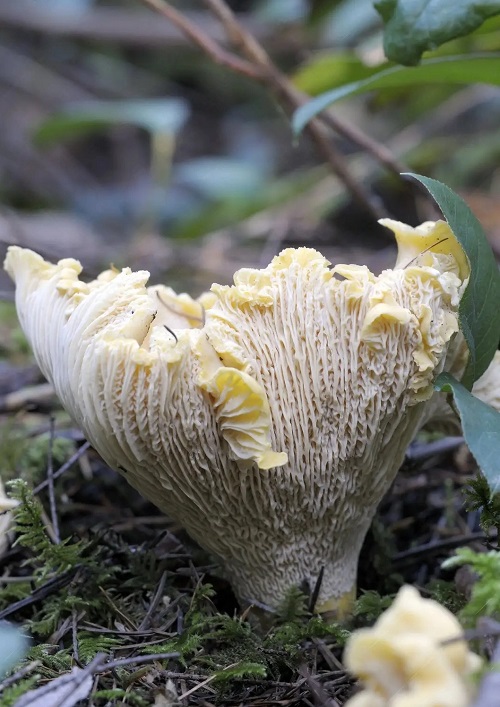Explore the Myriad of Common Missouri Mushrooms! This guide will give you a detailed insight on Fungal Wonders!
Discover a diverse array of Common Missouri Mushrooms with our comprehensive guide. From the prized Morels to the vibrant Chicken of the Woods, explore their seasons, habitats, edibility, and unique characteristics!
Learn Everything About Growing Mushrooms in Buckets here
Common Missouri Mushrooms
1. Morel
Scientific name: Morchella spp.
Season: April to May.
Habitat: Often found in wooded areas, near trees, and in grassy clearings.
Edibility: Generally considered edible when properly cooked, but avoid consuming raw or undercooked morels.
Morels are highly prized edible mushrooms with a distinctive honeycomb appearance. These Common Missouri Mushrooms come in various sizes and colors, ranging from pale yellow to dark brown.
2. Chanterelle
Scientific name: Cantharellus spp.
Season: June to September
Habitat: Found in forests, often near hardwood trees.
Edibility: Edible and considered a gourmet mushroom.
Chanterelles have a trumpet-like shape and range in color from bright yellow to orange. They have a fruity and peppery aroma, and their flavor is often described as delicate and earthy. They don’t have true gills; instead, they have ridges on the underside.
3. Chicken of the Woods
Scientific name: Laetiporus spp.
Season: May to June.
Habitat: Typically found on hardwood trees, especially oak and chestnut.
Edibility: Edible when young and tender, but some individuals might experience digestive discomfort. Cook well before eating.
These Common Missouri Mushrooms have a vibrant orange-to-yellow color and grow in shelf-like clusters. Their overlapping layers resemble chicken meat, hence the name. They have a mild and savory flavor, somewhat reminiscent of chicken or seafood.
4. Oyster Mushroom
Scientific name: Pleurotus spp.
Season: March to November.
Habitat: Often found on dead or decaying wood, such as tree stumps and fallen logs.
Edibility: Edible and widely cultivated for consumption.
Oyster mushrooms have a characteristic fan or oyster-like shape with a delicate flavor. These Common Missouri Mushrooms come in various colors, including white, gray, and pink. They can grow in large clusters and are commonly used in cooking.
5. Black Trumpet
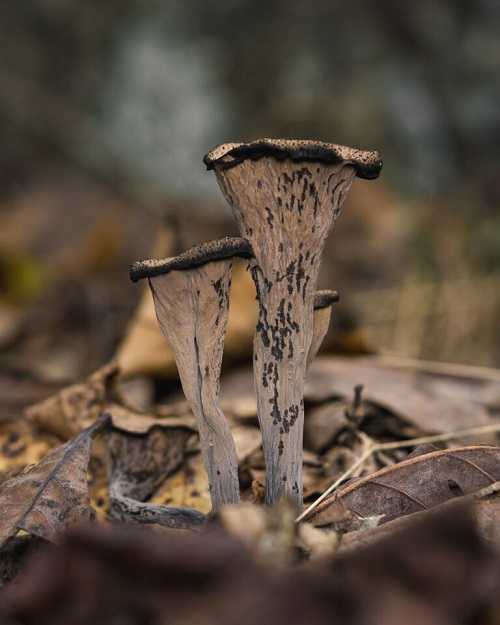
Scientific name: Craterellus spp.
Season: July to November.
Habitat: Found in wooded areas, often near hardwood trees.
Edibility: Edible and highly sought after for culinary purposes.
Black trumpets are dark-colored and trumpet-shaped with a wavy cap. They have a unique smoky and earthy flavor that intensifies when dried. They can be challenging to spot due to their dark color and blending in with the forest floor.
Learn Growing Mushrooms in Coffee Grounds here
6. Shaggy Mane
Scientific name: Coprinus comatus
Season: May to October.
Habitat: Commonly found in disturbed areas, lawns, and meadows.
Edibility: Edible when young and white; they “melt” into black goo as they mature.
Shaggy manes have a tall, cylindrical shape with white scales on the cap. When young, they have an edible, delicate flavor. However, these Common Missouri Mushrooms rapidly turn black and liquefy as they mature, making identification important.
7. Lion’s Mane
Scientific name: Hericium spp.
Season: August to November.
Habitat: Typically found on hardwood trees.
Edibility: Edible and valued for its unique appearance and potential health benefits.
Lion’s Mane mushrooms have cascading, white spines that resemble a lion’s mane. They have a mild and slightly sweet flavor. These Common Missouri Mushrooms are popular for their potential cognitive and nerve health benefits.
8. Reishi
Scientific name: Ganoderma spp.
Season: Year-round, often in warmer months.
Habitat: Found on tree trunks and logs, especially on hardwoods.
Edibility: Not typically consumed due to their tough and woody texture, but used for medicinal purposes.
Reishi mushrooms have a glossy, reddish-brown surface and a flat, kidney-shaped appearance. They are highly valued in traditional medicine for their potential immune-boosting and antioxidant properties.
9. Amanitas
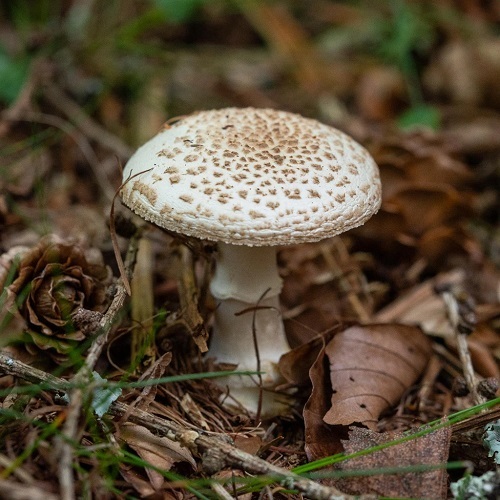
Scientific name: Amanita spp.
Season: Varies by species.
Habitat: Varies by species; some are associated with trees, while others are found in grassy areas.
Edibility: Some Amanita species are toxic and potentially deadly; others may be edible when properly prepared. Extreme caution is necessary due to the presence of poisonous species.
Amanita mushrooms come in various colors and shapes. These Common Missouri Mushrooms stand out with their characteristic ring (annulus) around the stem and their cup-like structure (volva) at the base.
10. Bolete
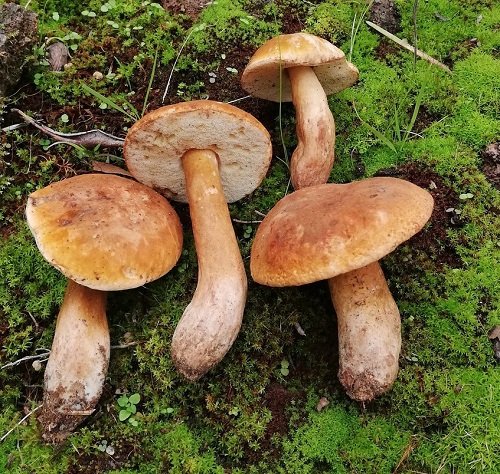
Scientific name: Boletus spp.
Season: May to November.
Habitat: Found in various habitats, including deciduous and coniferous forests.
Edibility: Many bolete species are edible, but some can be toxic. Proper identification is essential.
Bolete mushrooms have a distinct appearance with a cap and a thick, often bulbous stem. These Common Missouri Mushrooms usually have a pore surface (instead of gills) underneath the cap.
Check out the Most Toxic Mushrooms Found Easily in Garden here
11. Honey Mushroom

Scientific name: Armillaria spp.
Season: September to November.
Habitat: Often found on wood, tree stumps, and roots.
Edibility: Some species are edible, but identification can be challenging. Some honey mushrooms are known to cause digestive upset in certain individuals.
Honey mushrooms have honey-colored to brown caps with gills underneath. They can form large clusters and have a distinct annulus (ring) on the stem. Some species are parasitic and can cause wood decay.
12. Cauliflower Mushroom
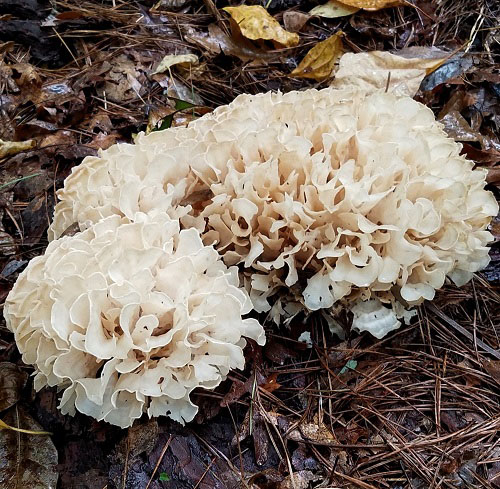
Scientific name: Sparassis spp.
Season: September to October.
Habitat: Typically found near the base of hardwood trees.
Edibility: Edible and prized for its unique appearance and flavor.
Cauliflower mushrooms have a distinctive appearance with a ruffled, cauliflower-like structure. These Common Missouri Mushrooms are pale to creamy white and have a slightly nutty and mild flavor. They can be quite large and are often used in cooking.
13. Turkey Tail

Scientific name: Trametes versicolor
Season: Year-round.
Habitat: Common on dead wood, including logs and stumps.
Edibility: Not generally considered edible due to their tough and woody texture, but they are used for medicinal purposes.
Turkey Tail mushrooms have concentric rings of various colors on their caps, resembling a turkey’s tail feathers. They are known for their potential immune-modulating and health-supportive properties, especially in traditional medicine.
14. Crimini Mushroom
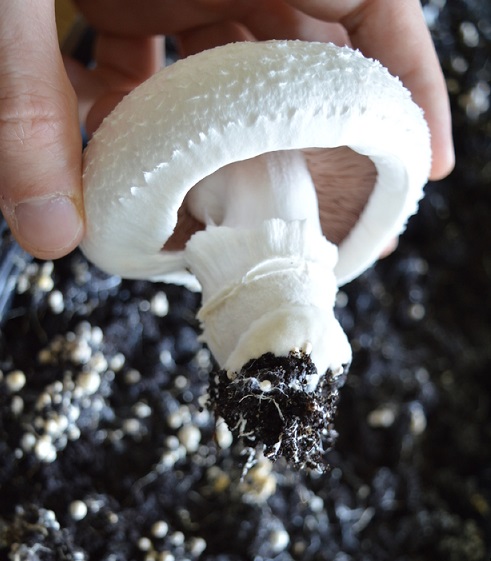
Scientific name: Agaricus bisporus
Season: Year-round.
Habitat: Often cultivated in compost or manure-enriched soil.
Edibility: Edible and commonly used in cooking.
Crimini mushrooms are closely related to the white button mushroom and have a similar appearance. They start as white buttons and darken to a light brown when mature. These Common Missouri Mushrooms have a mild flavor.
15. Lobster Mushroom
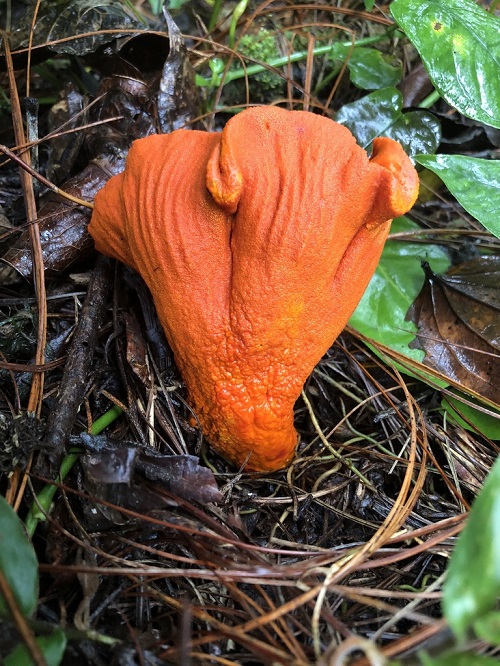
Scientific name: Hypomyces lactifluorum
Season: August to October.
Habitat: Parasitic on other mushrooms, often growing on them.
Edibility: Edible and sought after, but technically it’s a mushroom-parasite combination.
The lobster mushroom is parasitized, often a russula or lactarius species, covered by a bright orange-red crust. It has a seafood-like aroma and flavor, hence the name “lobster.”
Find out if you Can Compost Mushrooms here
16. Destroying Angel

Scientific name: Amanita bisporigera
Season: July to October.
Habitat: Associated with hardwood forests.
Edibility: Highly toxic and potentially deadly. Consumption can lead to severe illness or death.
Destroying Angels are deadly poisonous mushrooms with a white cap, white gills, and a volva at the base. These Common Missouri Mushrooms can be mistaken for edible mushrooms, making accurate identification crucial for safety.
17. Puffball Mushroom
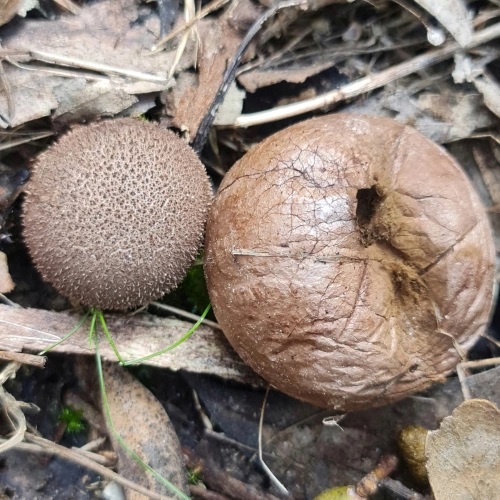
Scientific name: Calvatia spp.
Season: July to October.
Habitat: Found in various habitats, including grassy areas and woodlands.
Edibility: Edible when young and the flesh is pure white. They should not be consumed once they begin to turn yellow or develop an inner mass.
Puffball mushrooms are round and often white when young. As they mature, they release spores through an opening at the top. They have a soft, spongy texture when edible.
18. Shiitake Mushroom
Scientific name: Lentinula edodes
Season: Year-round.
Habitat: Cultivated on hardwood logs or artificial substrates.
Edibility: Edible and popular in culinary dishes.
Shiitake mushrooms have a broad, umbrella-shaped cap with a brown color. They have a meaty and savory flavor when cooked and are commonly used in Asian and international cuisine.
19. Hen of the Woods
Scientific name: Grifola frondosa
Season: September to October.
Habitat: Found at the base of hardwood trees.
Edibility: Edible and valued for its unique texture and flavor.
Hen of the Woods mushrooms has a frilly, layered appearance, resembling a hen’s ruffled feathers. These Common Missouri Mushrooms are typically gray-brown and have a strong earthy and savory flavor.
20. Inky Cap

Scientific name: Coprinopsis atramentaria
Season: May to October.
Habitat: Commonly found in grassy areas, lawns, and disturbed soil.
Edibility: Edible when young, but they should not be consumed with alcohol due to potential adverse effects.
Inky Cap mushrooms have black gills that turn into an inky liquid as they mature. They have a thin, elongated cap and slender stem. They are known for their rapid deliquescence, where the cap and stem liquefy and dissolve.
Find the Best Edible Long Stemmed Mushrooms here
21. Yellow Morel
Scientific name: Morchella esculenta
Season: April to May.
Habitat: Found in wooded areas, often near trees.
Edibility: Generally considered edible when cooked, but caution is advised when foraging.
Yellow Morels are a variety of prized morel mushrooms. They have a distinctive honeycomb appearance, with pale yellow to tan caps. Like other morels, these Common Missouri Mushrooms are sought after for their unique flavor and texture.
22. Scaly Vase Chanterelle
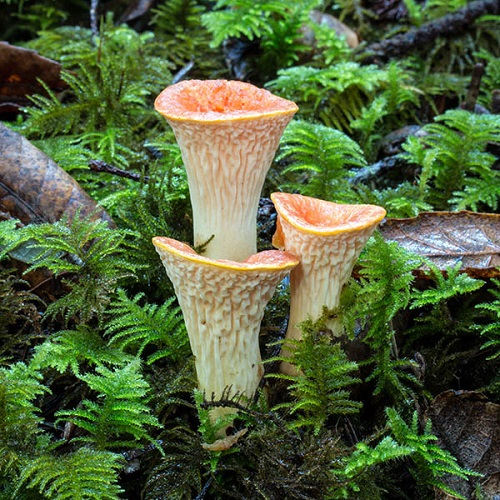
Scientific name: Gomphus floccosus
Season: July to September.
Habitat: Typically found in woodland areas.
Edibility: Edible and considered flavorful.
Scaly Vase Chanterelles have a vase-like shape with scaly caps. They range in color from pale yellow to orange-brown. Their flavor is often described as fruity and mildly peppery.
23. Artist’s Conk
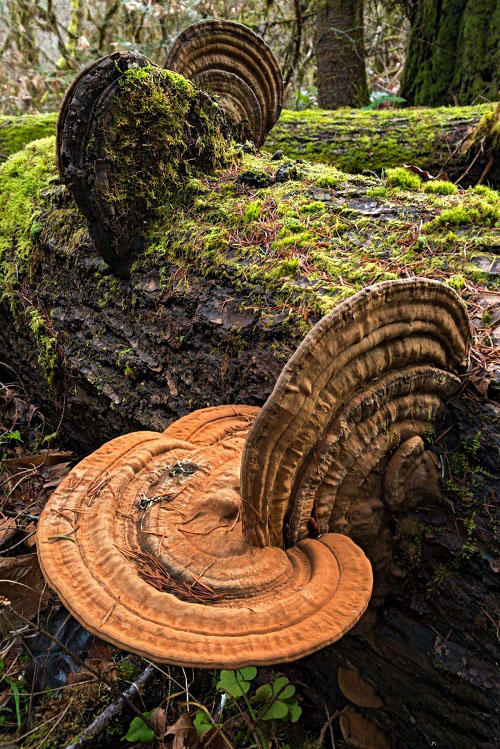
Scientific name: Ganoderma applanatum
Season: Year-round.
Habitat: Commonly found on tree trunks.
Edibility: Not typically consumed, but used for artistic purposes.
Artist’s Conk has a white underside that turns brown when scratched or written upon. It’s often used by artists for sketching or writing. The upper surface of these Common Missouri Mushrooms can be quite large and flat.
24. Old Man of the Woods
Scientific name: Strobilomyces floccopus
Season: August to October.
Habitat: Associated with pine trees and coniferous forests.
Edibility: Generally not considered toxic but not widely consumed.
Old Man of the Woods mushrooms have a shaggy appearance with a dark brown to black cap. These Common Missouri Mushrooms have a somewhat woolly texture, and their appearance can resemble forest debris.
25. Pine Mushroom

Scientific name: Tricholoma magnivelare
Season: September to October.
Habitat: Typically found near pine trees.
Edibility: Edible and valued for their unique aroma and flavor.
Pine mushrooms have a medium to large cap with a pale color and distinctive pine scent. They are often used in Asian cuisine and have a meaty, nutty flavor.
Find Plants that Don’t Like Mushrooms here
26. Hedgehog Mushroom
Scientific name: Hydnum repandum
Season: August to November.
Habitat: Found in woodland areas, often under hardwood trees.
Edibility: Edible and favored for their delicate flavor.
Hedgehog mushrooms have a distinctive appearance with spines underneath the cap. They are typically cream to orange-brown and have a mild, nutty flavor. The spines are a key identifying feature.
27. Pheasant Back Mushroom
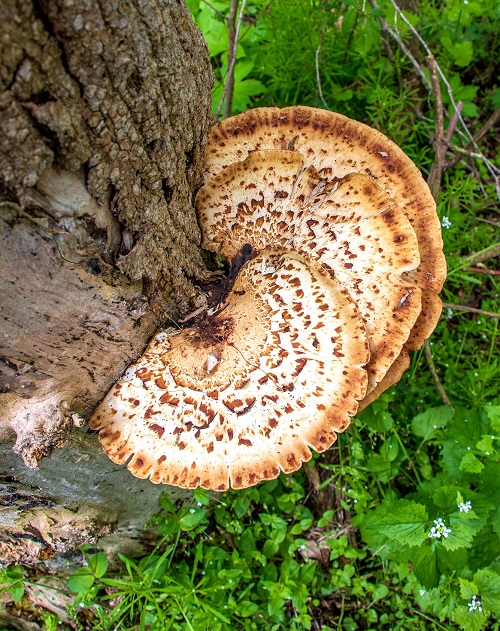
Scientific name: Cerioporus squamosus
Season: May to October.
Habitat: Commonly found on trees, particularly oaks.
Edibility: Edible when young and tender; the texture becomes tough as it ages.
Pheasant Back mushrooms have a fan-shaped cap with brown scales resembling pheasant feathers. These Common Missouri Mushrooms are often found in overlapping clusters and have a mild flavor.
28. Cinnamon Cap
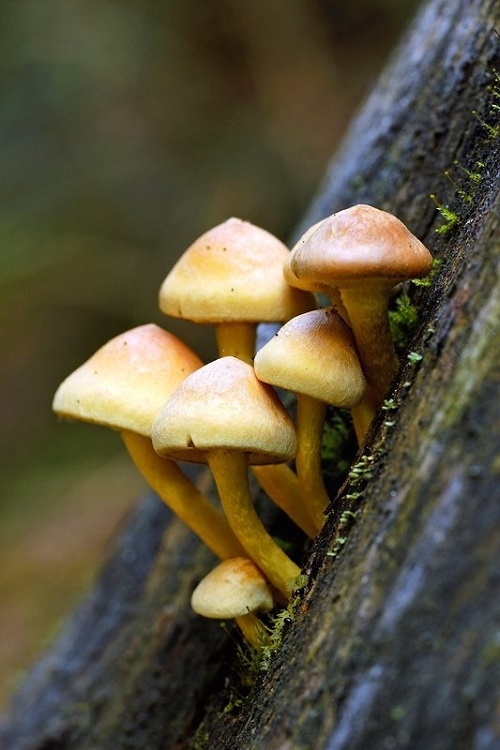
Scientific name: Hypholoma fasciculare
Season: May to November.
Habitat: Found on wood, logs, and stumps.
Edibility: Considered toxic and not recommended for consumption.
Cinnamon Cap mushrooms have a rusty brown cap and typically grow in clusters. They have gills and a tall stem. Despite their attractive appearance, they are not edible due to their potential toxicity.
29. False Morel
Scientific name: Gyromitra spp.
Months: March to May.
Habitat: Often found in forests and woodland areas.
Edibility: Generally considered toxic and potentially deadly. Avoid consumption.
False Morels are characterized by their irregular, brain-like appearance. They can range in color from brown to reddish. It’s crucial to avoid consuming false morels, as they contain potentially harmful compounds.
30. Chestnut Mushroom
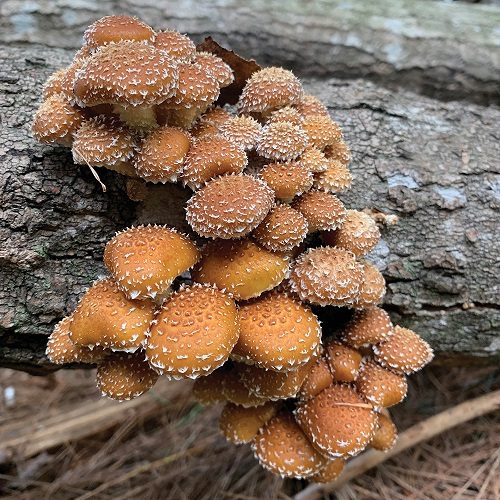
Scientific name: Pholiota adiposa
Months: September to November.
Habitat: Often found on decaying wood and tree stumps.
Edibility: Edible when young and the gills are still white; they become inedible as they mature.
Chestnut mushrooms have a chestnut-brown cap with a distinctive conical shape. The gills are initially white but turn dark brown as the mushroom matures. These Common Missouri Mushrooms have a mild and nutty flavor.
Check out Quirky Mushrooms That Look Like a Brain here
31. Black Morel
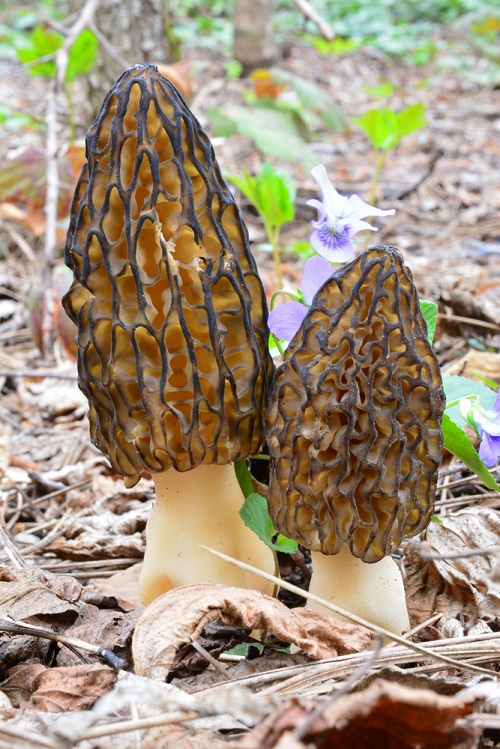
Scientific name: Morchella angusticeps
Months: April to May.
Habitat: Found in similar habitats as other morel species, often in wooded areas.
Edibility: Generally considered edible when cooked, but caution is advised when foraging.
Black Morels are a variety of morel mushrooms with a dark, elongated appearance. They have a honeycomb-like surface and are sought after for their distinctive flavor and texture.
32. American Caesar’s Mushroom
Scientific name: Amanita jacksonii
Months: May to October.
Habitat: Typically found in hardwood and mixed forests.
Edibility: Considered edible by some, but extreme caution is necessary due to the presence of toxic Amanita species.
American Caesar’s Mushroom has a pale to reddish-brown cap with a distinctive volva at the base. It resembles the well-known Caesar’s Mushroom (Amanita caesarea) found in Europe. Proper identification is crucial to avoid toxic look-alikes.
33. Candy Cap
Scientific name: Lactarius fragilis
Season: September to November.
Habitat: Often found in coniferous forests.
Edibility: Edible and highly aromatic; used for flavoring sweet dishes.
Candy Caps are small to medium-sized mushrooms with a reddish-brown cap. They are known for their sweet, maple syrup-like aroma when dried. These Common Missouri Mushrooms are used to add a unique flavor to desserts and baked goods.
34. Giant Puffball

Scientific name: Calvatia gigantea
Season: July to October.
Habitat: Found in grassy areas, lawns, and fields.
Edibility: Edible when young and white inside.
Giant Puffballs are some of the largest edible mushrooms. When young, they are spherical and white. As they mature, they can grow quite large, but they should be harvested while still firm and white for optimal edibility.
35. Ghost Pipe
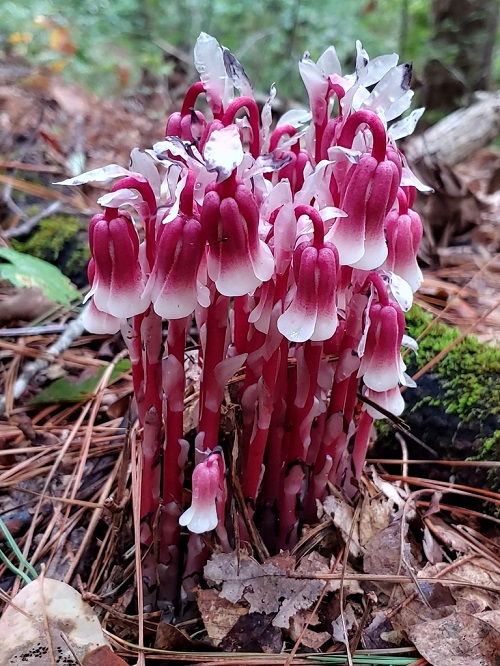
Scientific name: Monotropa uniflora
Season: May to September.
Habitat: Typically found in shaded, damp areas.
Edibility: Not edible; non-photosynthetic plant.
Ghost Pipe, also known as Indian Pipe, is not a mushroom but rather a non-photosynthetic plant. It appears ghostly white or pale due to its lack of chlorophyll. These Common Missouri Mushrooms are common in forest understories.
Learn About Common Flowers that are Poisonous here
36. Indigo Milk Cap
Scientific name: Lactarius indigo
Season: August to October.
Habitat: Often found in mixed hardwood and coniferous forests.
Edibility: Edible but not commonly consumed due to a strong flavor.
Indigo Milk Cap has a striking blue color and exudes blue latex when cut or damaged. It’s known for its vibrant appearance but is often avoided due to its bitter taste.
37. Red Chanterelle
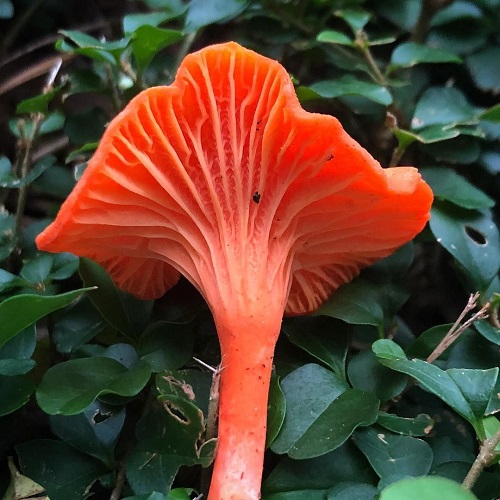
Scientific name: Cantharellus cinnabarinus
Season: June to October.
Habitat: Typically found in wooded areas.
Edibility: Edible but considered inferior to other chanterelle species.
Red Chanterelles have a reddish-to-orange color and a funnel-like shape. These Common Missouri Mushrooms are related to the golden chanterelle but are generally smaller and less esteemed in culinary use.
38. Meadow Mushroom
Scientific name: Agaricus campestris
Season: May to October.
Habitat: Common in grassy areas, lawns, and meadows.
Edibility: Edible and widely recognized as a common mushroom.
Meadow Mushrooms are often found in grassy areas and have a classic mushroom appearance with a white cap and pink to brown gills. They are commonly encountered due to their habitat.
39. White Chanterelle
Scientific name: Cantharellus subalbidus
Season: June to August.
Habitat: Found in wooded areas.
Edibility: Edible and similar to other chanterelle species.
White Chanterelles have a pale white color and a funnel-like shape. These Common Missouri Mushrooms share characteristics with other chanterelle species and are appreciated for their delicate flavor.
40. Stinkhorn Mushroom
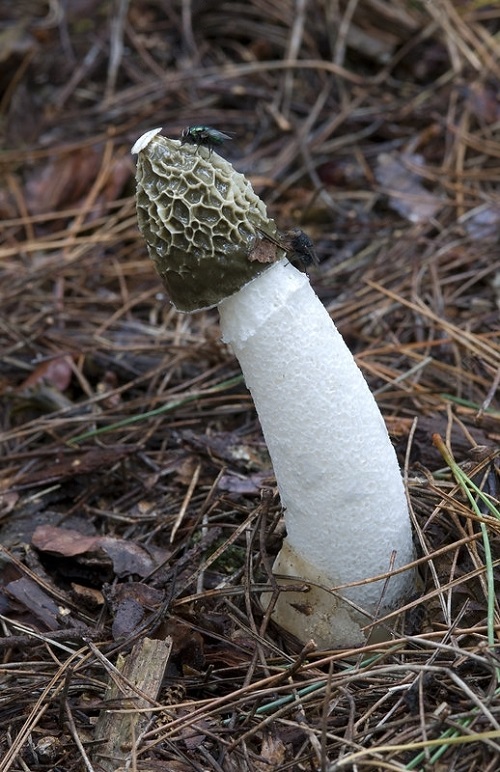
Scientific name: Phallus impudicus
Season: May to October.
Habitat: Often found in woods, gardens, and other organic-rich environments.
Edibility: Not typically consumed due to strong odor and texture.
Stinkhorn mushrooms are known for their foul-smelling odor, which attracts flies that aid in spore dispersal. They have a phallic shape and are often considered strange or unsightly.


